Lexicon MPX110 Owner's Manual
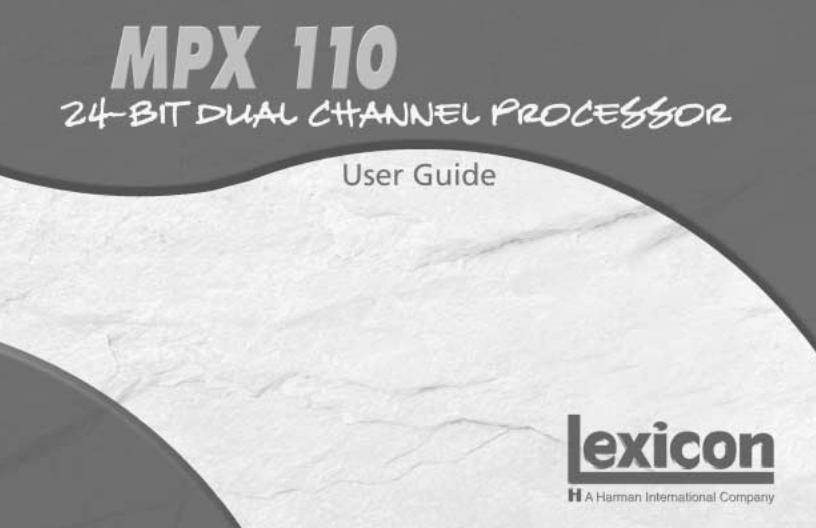

CE COMPLIANCE INFORMATION (FOR EUROPEAN MARKET)
EMC Directive 89/336/EEC and Amendment 92/31/EEC, Class B Digital Device.
EN 50081-1, Generic Emissions Standard for Residential, Commercial and Light Industrial Products.
(EN 55022/CISPR 22, Limits and Methods of Measurement of Radio Interference Characteristics Information Technology Equipment.) Warning: This is a Class B product. In a domestic environment this product may cause radio interference in which case the user may be required to take adequate measures.
EN 50082-1, Generic Immunity Standard for Residential, Commerical and Light Industrial Products. (IEC 801-2, IEC 801-3, IEC 801-4)
Directive EMC 89/336/CEE et amendement 92/31/CEE, dispositif numérique de Classe B.
EN 50081-1, Norme sur les émissions génériques pour les produits domestiques, commerciaux et industriels légers.
(EN 55022/CISPR 22, Limites et méthodes de mesure des caractéristiques d’interférences radiophoniques, Matériel des technologies de l’information.) Mise en garde: ceci est un produit de Classe B. Il risque produire des interférences radiophoniques dans un environnement domestique auquel cas l’utilisateur peut se voir demandé de prendre des mesures adéquates.
EN 50082-1, Norme sur l’immunité générique pour produits domestiques, commerciaux et industriels légers. (CEI 801-2, CEI 801-3, CEI 801-4)
EMC Richtlinie 89/336/EEC und Änderung 92/31/EEC, Digitales Gerät der Klasse B.
EN 50081-1, Allgemeiner Emissions - Standard für Haushalt - und kommerzielle Produkte sowie Erzeugnisse der Leichtindustrie.
(EN 55022/CISPR 22, Beschränkungen und Verfahren der Messung von informationstechnischen Ausrüstungen mit Funkstörmerkmalen.)
Warnung: Dies ist ein Erzeugnis der Klasse B. Dieses Erzeugnis kann Funkstörungen im Wohnbereich verursachen; in diesem Fall können entsprechende Maßnahmen seitens des Benutzers erforderlich sein.
EN 50082-1, Allgemeiner Unempfindlichkeits - Standard fur Haushalt - und kommerzielle Produkte sowie Erzeugnisse der Leichtindustrie. (IEC 801-2, IEC 801-3, IEC 801-4)

This equipment has been tested and found to comply with the limits for a Class B digital device, pursuant to Part 15 of the FCC Rules. These limits are designed to provide reasonable protection against harmful interference in a residential installation. This equipment generates, uses and can radiate radio frequency energy and, if not installed and used in accordance with manufacturer’s instructions, may cause harmful interference to radio communications. However, there is no guarantee that interference will not occur in a particular installation. If this equipment does cause harmful interference to radio or television reception, which can be determined by turning the equipment off and on, the user is encouraged to try to correct the interference by one or more of the following measures:
1.Re-orient the receiving antenna.
2.Increase the separation between the equipment and receiver.
3.Connect the equipment to an outlet on a circuit different from that to which the receiver is connected,.
4.Consult the dealer or an experienced radio/TV technician for help.
•The use of shielded cables for connection of the monitor to the graphics card is required to ensure compliance with FCC regulations.
•Changes or modifications to this unit not expressly approved by the party responsible for compliance could void the user’s authority to operate this equipment.
 A Harman International Company
A Harman International Company
Lexicon, Inc.
3 Oak Park
Bedford, MA 01730-1441 USA Tel 781-280-0300
Fax 781-280-0490 www.lexicon.com
Customer Support
Tel 781-280-0300
Fax 781-280-0495 (Sales)
Fax 781-280-0499 (Service)
Lexicon Part No. 070-14956 | Rev 1 | 02/02
© 2002 Lexicon, Inc. All rights reserved.
This document should not be construed as a commitment on the part of Lexicon, Inc. The information it contains is subject to change without notice. Lexicon, Inc. assumes no responsibility for errors that may appear within this document.

Introduction
Lexicon
Introduction |
|
|
US |
Important User Information. . . . . . . . . . . . . |
. iv |
DE |
Wichtige Benutzerinformation . . . . . . . . . . . |
. v |
ES |
Información importante para el usuario . . . . . |
vi |
FR |
Important - Informations Utilisateur . . . . . . . |
vii |
IT |
Importanti informazioni per l’utente. . . . . . . |
viii |
PT |
Informações Importantes ao usuário . . . . . . . |
ix |
Section 1: Getting Started
About the MPX 110 . . . . . . . . . . . . . . . . . . . . . . . . 1-2
Highlights
Front Panel Overview . . . . . . . . . . . . . . . . . . . . . . . 1-4
Rear Panel Overview . . . . . . . . . . . . . . . . . . . . . . . 1-6
Connecting the Unit . . . . . . . . . . . . . . . . . . . . . . . 1-8
Headphones • Footswitch
Setting Audio Levels . . . . . . . . . . . . . . . . . . . . . . . 1-10
Reinitialization . . . . . . . . . . . . . . . . . . . . . . . . . . . 1-11
Section 2: Basic Operation
Adjust . . . . . . . . . . . . . . . . . . . . . . . . . . . . . . . . . . 2-2
Selecting Programs . . . . . . . . . . . . . . . . . . . . . . . . 2-2
SINGLE Programs • DUAL Programs • User Programs
Editing Programs . . . . . . . . . . . . . . . . . . . . . . . . . . 2-4
Storing Programs . . . . . . . . . . . . . . . . . . . . . . . . . . 2-4
Tap Tempo . . . . . . . . . . . . . . . . . . . . . . . . . . . . . . 2-5
Varying Rhythm • Audio Tap • Global Tempo
Bypass. . . . . . . . . . . . . . . . . . . . . . . . . . . . . . . . . . 2-6
ii

MPX 110
Introduction
Section 3: System Mode
Overview. . . . . . . . . . . . . . . . . . . . . . . . . . . . . . . . 3-2
System Mode Parameters & Functions . . . . . . . . . . 3-3
Section 4: Program Descriptions
SINGLE Programs. . . . . . . . . . . . . . . . . . . . . . . . . . 4-2
Plate • Gate • Hall • Chamber • Ambience • Room • Tremolo • Rotary • Chorus • Flange • Pitch • Detune • Delay, Echo
Special FX . . . . . . . . . . . . . . . . . . . . . . . . . . . . . . 4-18
DUAL Programs . . . . . . . . . . . . . . . . . . . . . . . . . . 4-20
Effects Lvl/Bal • Flange-Delay • Pitch-Delay • Chorus-Delay •
Delay-Reverb • Flange-Reverb • Pitch-Reverb • Chorus-Reverb
The Pitch Programs . . . . . . . . . . . . . . . . . . . . . . . 4-36
User Programs . . . . . . . . . . . . . . . . . . . . . . . . . . . 4-38
Section 5: MIDI Operation
Learn Mode. . . . . . . . . . . . . . . . . . . . . . . . . . . . . . 5-2
Program Load Channel. . . . . . . . . . . . . . . . . . . . . . 5-3
Program Change Messages . . . . . . . . . . . . . . . . . . 5-4
Loading Programs • Activating Bypass or Tap Functions
Learning Continuous Controllers. . . . . . . . . . . . . . . 5-6
Section 5: MIDI Operation (continued)
Clearing Learned Assignments . . . . . . . . . . . . . . . . 5-7
MIDI Clock . . . . . . . . . . . . . . . . . . . . . . . . . . . . . . 5-8
MIDI Dumps . . . . . . . . . . . . . . . . . . . . . . . . . . . . . 5-8
MIDI Sysex Messages . . . . . . . . . . . . . . . . . . . . . . . 5-9
Permanent Patches . . . . . . . . . . . . . . . . . . . . . . . . 5-9
MIDI Implementation Chart . . . . . . . . . . . . . . . . . 5-12
Appendix
Specifications. . . . . . . . . . . . . . . . . . . . . . . . . . . . . A-2
Declaration of Conformity . . . . . . . . . . . . . . . . . . . A-3
Index
iii

Introduction
Lexicon
US Important User Information
Lexicon is pleased to present its user guides on CD-ROM. By utilizing CD-ROM technology we are able to provide our documentation in multiple languages.
The printed edition of the user guide is in English only. The enclosed CD-ROM includes the user guide in multiple languages (French, German, Italian, Portuguese, and Spanish) in easy-to-use PDF format. The CD-ROM also includes Adobe® Acrobat® Readers for both PC and Macintosh platforms, enabling printing of all or any part of the documents. In addition, we have included dry audio tracks for product demonstrations. (Track 1 contains non-audio data.)
Please take a moment to read through the important safety information. For additional information about Lexicon, Inc., our products and support, please visit our web site at www.lexicon.com.
Unpacking and Inspection
After unpacking the unit, save all packing materials in case the unit ever needs to be shipped. Thoroughly inspect the modules and packing materials for signs of damage. Report any damage to the carrier at once; report equipment malfunction to the dealer.
iv

MPX 110
Introduction
DE Wichtige Benutzerinformation
Lexicon ist erfreut, seine Benutzerhandbücher nun auch auf CD-ROM vorlegen zu können. Durch den Einsatz von CD-ROM-Technologie können wir unsere Dokumentation in verschiedenen Sprachen zur Verfügung stellen.
Die gedruckte Ausgabe des Benutzerhandbuchs ist nur in englischer Sprache verfügbar. Die beigelegte CD-ROM enthält das Benutzerhandbuch in verschiedenen Sprachen (spanisch, französisch, italienisch, deutsch und portugiesisch) im leicht zu benutzenden PDF-Format. Die CD-ROM enthält auch Adobe® Acrobat® Reader sowohl für PC wie auch für Macintosh; mit ihm ist es möglich, das gesamte Dokument oder Teile davon auszudrucken. Darüber hinaus befinden sich auf der
CD-ROM Audio-Tracks zur Produktdemonstration.
(Track 1 enthält keine Audio-Daten.)
Nehmen Sie sich bitte einen Augenblick Zeit und lesen Sie die wichtigen Sicherheitshinweise. Weitere Informationen über Lexicon, Inc., sowie über unsere Produkte und unseren Support finden Sie auf unserem Website unter www.lexicon.com.
Auspacken und Überprüfung
Bewahren Sie nach dem Auspacken des Geräts das Verpackungsmaterial für den Fall auf, dass Sie das Gerät wieder versenden müssen. Überprüfen Sie die Module und die Verpackung sorgfältig auf Anzeichen von Beschädigung. Etwaige Schäden sind dem Transporteur unverzüglich anzuzeigen; Funktionsstörungen sind dem zuständigen Händler zu melden.
v

Introduction
Lexicon
ES Información importante para el usuario
Lexicon se complace en presentar sus manuales de usuario en CD-ROM. Gracias a la utilización de la tecnología de CD-ROM, nosotros podemos ofrecer nuestra documentación en múltiples idiomas.
La edición impresa del manual del usuario sólo está disponible en inglés. El CD-ROM que se entrega incluye el manual del usuario en múltiples idiomas (español, francés, italiano, alemán y portugués) en formato PDF. El CD-ROM también incluye Adobe® Acrobat® Readers para plataformas tanto PC como Macintosh, lo cual permite la impresión de todos o parte de los documentos. Además, hemos incluido pistas de audio sin efectos para demostraciones de los productos. (La pista 1 contiene información que no es de audio.)
Dedique unos momentos a leer la información de seguridad importante. Si desea información adicional acerca de Lexicon, Inc., nuestros productos o nuestra asistencia, visite nuestro sitio web en www.lexicon.com.
Desembalaje e inspección
Después de desembalar la unidad, guarde todos los materiales de embalaje por si alguna vez transportar la unidad. Inspeccione con atención los módulos y los materiales de embalaje para comprobar que no muestren desperfectos. Informe inmediatamente de cualquier desperfecto al transportista; informe de cualquier problema de funcionamiento del equipo a su distribuidor.
vi

MPX 110
Introduction
FR Important - Informations Utilisateur
Nous sommes fiers de présenter nos modes d’emploi en version CD-ROM. L’utilisation des CD-ROM nous per-mettent de décliner nos manuels en plusieurs langues.
La version imprimée de ce manuel existe uniquement en anglais. Le CD-ROM regroupe les versions espagnole, française, italienne, allemande et portugaise au format PDF. Le CD-ROM comprend également Adobe® Acrobat® Reader pour PC et Macintosh, ce qui vous permet d’imprimer les documents en toute ou partie. De plus, nous avons ajouté des pistes audio sans traitement pour la démonstration du produit (la piste 1 contient des données non audio).
Prenez le temps de lire les informations relatives à la sécurité. Pour obtenir de plus amples informations sur Lexicon, Inc., nos produits et notre service clientèle, consultez notre site web à l’adresse : www.lexicon.com.
Contenu de l’emballage et inspection
Après avoir ouvert l’emballage, conservez-le pour tout retour. Inspectez avec soin les modules et les matériaux d’emballage pour tout signe de dommage. Veuillez rapporter immédiatement les dommages auprès du transporteur. Les dysfonctionnements du matériel doivent être signalés à votre revendeur.
vii

Introduction
Lexicon
IT Importanti informazioni per l’utente
Lexicon è lieta di presentare i propri manuali su CDROM. Utilizzando la tecnologia su CD-ROM siamo stati capaci offrire la nostra documentazione in più lingue.
L’edizione stampata del manuale è solamente in inglese. Il CD-ROM contiene il manuale in diverse lingue (Spagnolo, Francese, Italiano, Tedesco, e Portoghese)in formato PDF, facile da utilizzare. Il CD-ROM include anche Adobe‚, Acrobat‚ Reader per PC e per Macintosh, rendendo possibile la stampa di tutta la documentazione. Inoltre Sono incluse tracce audio per dimostrazioni del prodotto. (La Traccia 1 contiene dati non audio).
Si prega di prendere un momento per leggere le importanti norme di sicurezza. Per ulteriori informazioni riguardo Lexicon, Inc., i nostri prodotti e la nostra assistenza, visiti il nostro sito internet www.lexicon.com.
Disimballaggio ed ispezione
Dopo aver disimballato l’unità, salvi tutto il materiale d’imballaggio, in caso Lei abbia bisogno di spedire l’unità. Ispezioni attentamente i moduli ed il materiale d’imballaggio per vedere se riportano segni di danno. Riporti subito ogni segno di danno al corriere; riferisca il malfunzionamento dell’attrezzatura al suo rivenditore.
viii

MPX 110
Introduction
PT Informações Importantes ao usuário
A Lexicon tem o prazer de apresentar o Guia do Usuário em CD-ROM. Através da tecnologia CD-ROM temos a possibilidade de fornecer nossa documentação em vários idiomas.
A versão impressa do Guia do Usuário está apenas em Inglês. O CD-ROM contém o Guia do Usuário em vários idiomas (Espanhol, Francês, Italiano, Alemão e Português) em formato PDF. Também inclui o aplicativo Adobe Acrobat Reader para as plataformas Macintosh e PC, possibilitanto a impressão de qualquer parte da documentação. Além disso, incluimos faixas no CD com áudio sem processamento para a demosntração dos produtos. (A faixa 1 do CD não contém informação de
áudio.)
Por favor separe uns instantes para ler as informações sobre segurança. Elas são muito importantes. Para informações adicionais sobre a Lexicon, Inc., nossos produtos e suporte, acesse nosso web site em www.lexicon.com.
Retirando a embalagem e Inspecionando
Depois de desembalar a unidade, guarde a embalagem caso precise enviar a unidade para manutenção. Inspecione cuidadosamente o módulo e a embalagem procurando sinais de dano. Avise à loja qualquer tipo de dano ou mal funcionamento do equipamento.
ix

|
1 |
|
Getting Started |
About the MPX 110......................................................................... |
1-2 |
Highlights |
|
Front Panel Overview ...................................................................... |
1-4 |
Rear Panel Overview ........................................................................ |
1-6 |
Connecting the Unit........................................................................ |
1-8 |
Headphones • Footswitch |
|
Setting Audio Levels ...................................................................... |
1-10 |
Reinitialization ............................................................................... |
1-11 |

Getting Started
Lexicon
ABOUT THE MPX 110
Thank you for purchasing the MPX 110 Dual Channel Processor, featuring Lexicon’s proprietary Lexichip®.
The MPX 110 is a true stereo, dual-channel processor with 24-bit internal processing, analog-to-digital conversion, and digital-to-analog conversion. It offers 240 presets with classic Lexicon reverbs, including Plate, Chamber, Ambience, Tremolo, Rotary, Chorus, Flange, Pitch, Detune, 5.7 second Delay, Echo, and Inverse. Dual-channel processing creates two independent effects in combinations such as Dual Stereo (Parallel), Cascade, Mono Split, and Dual Mono.
The front panel Adjust knob allows instant manipulation of critical preset parameters, and the Effects Lvl/Bal knob controls effect level in SINGLE programs or effect balance in DUAL programs. All programs can be selected with the PROGRAM and VARIATION knobs. The PROGRAM knob selects SINGLE, DUAL, or User programs, while the VARIATION knob selects among 16 program variations.
Tap Tempo simplifies the once-complicated process of matching delay times and modulation rates between tempo-based presets and other music. Tempo-controlled delays and modulation rates lock to Tap or MIDI clock. In addition, Tap can be controlled using audio input, a dual footswitch, the front panel Tap button, or an external MIDI controller using MIDI Continuous Controller or Program Change messages.
The MPX 110 features Learn Mode, a powerful editing tool that allows MIDI patching of five front panel controls. Standard Continuous Controller and Program Change messages provide complete control over Bypass, Effects Lvl/Bal, Mix, Tap, and even Adjust.
1-2

MPX 110
Getting Started
HIGHLIGHTS
•Lexicon’s proprietary Lexichip
•World-class Lexicon reverb
•24-bit internal processing
•24-bit analog-to-digital and digital-to-analog conversion
•240 presets
•16 User programs
•44.1K S/PDIF output
•Simultaneous analog and digital outputs
•Independent processing of each input
•DUAL programs that create two independent effects with four routing configurations
•Dual effects that combine Delay with Reverb, or either Delay or Reverb with Chorus, Flange, or Pitch
•Multiple delay, modulation, and pitch effects
•Tap Tempo
•Full MIDI control
•High-impedance inputs for instruments
•Two-stage headroom indicators
•Headphone output
•Software-selectable MIDI OUT/THRU port
•Push-button or footswitch selection of dry or muted audio output
•20Hz-20kHz±1dB frequency response
1-3
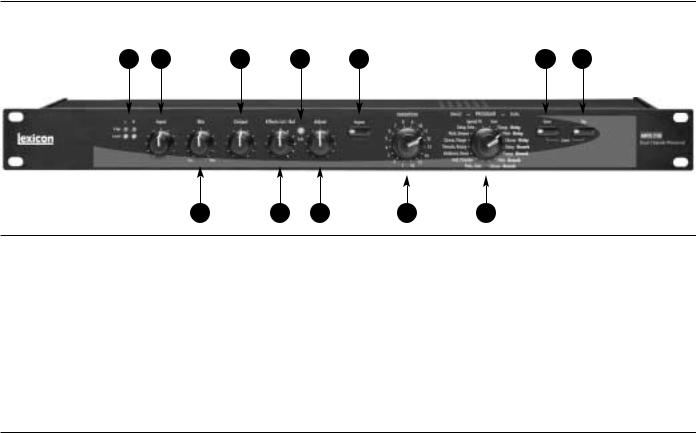
Getting Started
Lexicon
FRONT PANEL OVERVIEW
1 |
2 |
4 |
6 |
8 |
11 |
12 |
3 |
5 |
7 |
9 |
10 |
1.Clip and Level LEDs
Indicate incoming signal levels. The Level LEDs do not light when the incoming signal is more than 30dB below overload. The Clip LEDs light red when the signal approaches overload (-2.5dB). When a signal level is acceptable, the Level LEDs light green almost continuously and the Clip LEDs flash red on the loudest passages. See page 1-10 for more information about setting audio levels.
2.Input
Sets the level of the incoming signal. The Clip and Level LEDs indicate acceptable signal levels.
3.Mix
Controls the ratio of processed (Wet) to unprocessed (Dry) audio signals.
1-4

MPX 110
Getting Started
4. |
Output |
9. |
VARIATION |
|
Sets analog output levels. |
|
Selects program variations when the PROGRAM |
|
|
|
knob is set to a SINGLE or DUAL program. Selects |
5. |
Effects Lvl/Bal |
|
memory locations for storing User programs when |
|
the PROGRAM knob is set to User. |
||
|
Sets effect level in SINGLE programs or effect |
|
|
|
|
|
|
|
balance in DUAL programs. |
10. |
PROGRAM |
|
|
6.Edit LED
Lights to indicate that a program has been modified but not stored, and flashes to indicate MIDI activity. (See page 2-4 for more information about editing programs.)
7.Adjust
Selects SINGLE, DUAL, or User programs.
11.Store
Activates the store function for User programs. When pressed with Tap, activates MIDI Learn Mode.
12.Tap
Controls the most relevant parameters for the |
Flashes to indicate that a tempo-based program is |
|
selected program variation. |
selected. When pressed twice, sets tempo. When |
|
|
pressed and held, uses input level to determine |
|
8. Bypass |
tempo. When pressed with Store, activates MIDI |
|
Learn Mode. |
||
Mutes or bypasses the incoming signal, depending |
||
|
||
on the setting of the System Mode parameter |
|
|
Bypass. Press and hold for 2 seconds to access |
|
|
System Mode parameters. |
|
|
|
|
|
|
1-5 |
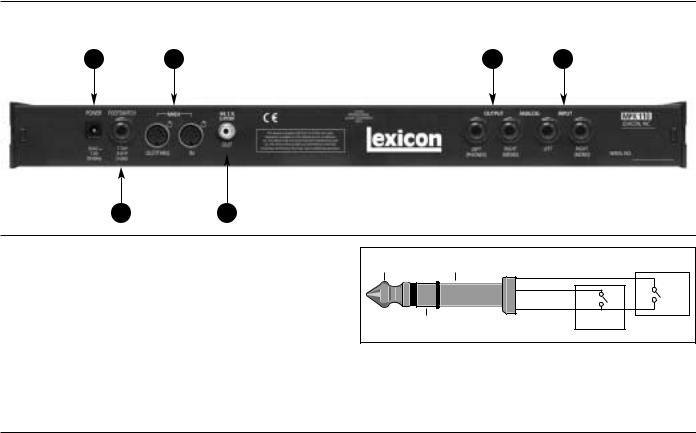
Getting Started
Lexicon
REAR PANEL OVERVIEW
1 |
3 |
5 |
6 |
2 |
4 |
1.POWER
Supplies power to the unit. Utilizes a Lexicon 1.9A, 9VAC power pack.
2.FOOTSWITCH
Tip |
|
Sleeve |
Tip |
|
|
|
|
|
|
|
|
|
Ring |
Tap |
|
Ring |
|
Sleeve |
Bypass |
|
|
|
|
Allows footswitch control of front panel Bypass and Tap functions. A 1/4 inch Tip/Ring/Sleeve connector for a momentary contact footswitch is available.
1-6

MPX 110
Getting Started
3.MIDI IN, OUT/THRU
Provide MIDI operation capabilities. Two 5-pin DIN MIDI connectors are available for MIDI IN and software-selectable MIDI OUT/THRU.
4.S/PDIF OUT
Provides digital audio output. One RCA coaxial S/PDIF connector is available.
5.ANALOG OUTPUTs
Provide analog audio output. Two unbalanced, single-ended stereo output connectors are available. Both offer typical output levels of +8dBu. Use the RIGHT (MONO) OUTPUT for mono output. If no connection is made to the RIGHT (MONO) OUTPUT, the LEFT (PHONES) OUTPUT can be used to drive headphones at a modest volume.
6.ANALOG INPUTs
Provide analog audio input. Two unbalanced, single-ended stereo input connectors are available.
Both accept levels as low as -30dBu. Input impedance is 500kΩ. These can be used as direct inputs for guitars. Use the RIGHT (MONO) INPUT for mono sources.
1-7

Getting Started
Lexicon
CONNECTING THE UNIT
The INPUT and OUTPUT connectors on the MPX 110 are 1/4 inch unbalanced sockets. Connections should be made utilizing high-quality shielded cables with 1/4 inch Tip/Sleeve phone plugs at the end connected to the unit.
The unit produces effects from either mono or stereo sources. For mono sources, use the RIGHT (MONO) INPUT. For instruments and stereo sources, use both inputs. It is recommended to use stereo outputs whenever stereo inputs are used. Use the RIGHT (MONO) OUTPUT if mono output is required. The left and right input signals are combined internally when only the RIGHT (MONO) OUTPUT is used.
HEADPHONES
The LEFT (PHONES) OUTPUT supplies a stereo signal adequate to drive headphones, provided no connections are made at the RIGHT (MONO) OUTPUT. This feature is included for convenience and practice purposes. It is intended to provide modest volume.
FOOTSWITCH
A footswitch connected to the rear panel FOOTSWITCH connector can be used to control front panel Tap and Bypass functions. A momentary footswitch can be wired to a Tip/Ring/Sleeve connector or a stereo Y-connector, which allows two identical switches to be used.
Note:
Power off the unit prior to connecting the footswitch. Otherwise, Bypass functions will be enabled.
Dual-Function Footswitch
A dual-function footswitch with labels to indicate Tap and Bypass functions is available at Lexicon dealers or www.lexicon.com.
BYPASS |
TAP |
1-8
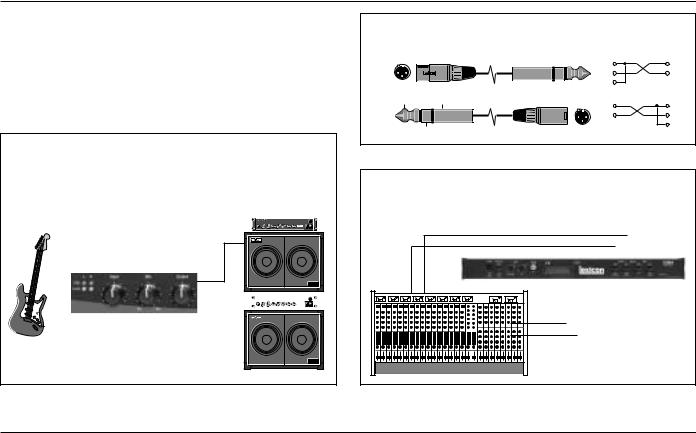
MPX 110
Getting Started
The MPX 110 can be used as two independent effects processors with DUAL program variations 11 to 16. Designate two auxiliary sends on the console. Connect these to the unit - one to the LEFT INPUT and the other to the RIGHT (MONO) INPUT. See Section 4 to take advantage of this configuration.
Connecting to a Mono Guitar Input with Mono or Stereo Amplifiers
Amplifier &
Stereo Speaker
Cabinet
|
Right |
|
(Mono) |
MPX 110 |
Output |
SB 210
|
|
|
|
|
|
|
|
|
|
|
|
|
|
|
|
|
|
|
|
|
|
|
|
|
|
|
|
|
|
|
|
to MPX 110 RIGHT |
Left |
|
|
|
|
||
(MONO) INPUT |
|
|
|
|
|||
Output |
|
|
|
|
|||
|
|
|
|
|
|
|
|
SB 210
Connecting to a Balanced Console
Mixer |
|
|
|
1 |
Tip |
|
|
|
2 |
Sleeve |
|
Send |
|
|
|
||
|
|
MPX 110 Input |
3 |
|
|
|
|
|
|
||
Tip |
Sleeve |
Mixer Input |
|
Tip |
1 |
MPX 110 |
|
|
|
||
|
|
Sleeve |
2 |
||
Output |
|
|
|||
|
|
|
|
3 |
|
|
Ring |
|
|
|
|
|
|
|
|
|
|
Connecting to a Dual Processor Setup with a Console
Ch7 |
Ch8 |
|
Aux |
|
Send 1 |
|
Aux |
|
Send 2 |
LEFT Out |
|
RIGHT Out |
|||
|
|||||
|
LEFT In |
|
RIGHT In |
||
|
|
||||
|
|
|
|
|
|
|
|
|
|
|
|
|
|
|
|
|
|
1-9

Getting Started
Lexicon
SETTING AUDIO LEVELS
1.Begin with the Input knob set to the 9 o’clock position.
2.Set the instrument or effects sends to a modest output level.
3.Begin playing or sending audio to the MPX 110. The Level LEDs should light green. If the Clip LEDs light red, reduce the output level of the instrument or effects sends until the Clip LEDs do not light during the loudest passages.
4.Continue to play or send audio to the MPX 110. Gradually increase the Input knob setting until the Clip LEDs light red on the loudest passages.
5.Set the Mix knob to Dry.
6.Set the Output knob to the desired level.
7.If utilizing console sends and returns, set the Mix knob to Wet. If utilizing an instrument amplifier, set the Mix knob to the 12 o’clock position.
The Level LEDs do not light when the incoming signal is more than 30dB below overload. The Clip LEDs light red when the signal approaches overload (-2.5dB). When an acceptable signal is present, the Level LEDs light green almost continuously and the Clip LEDs flash red on the loudest passages.
Note:
As with all audio products, it is good practice to first power on all outboard equipment, then the mixer, then the speakers.
1-10

MPX 110
Getting Started
REINITIALIZATION
The procedure below outlines the process to reinitialize the unit. When reinitialized, the unit will restore all System Mode parameters to their factory-default settings; replace all User programs with factory-default presets; and clear all Learned Patches.
To reinitialize the unit:
1.While powering the unit on, press and hold the front panel Store button until the Store and Tap LEDs flash quickly.
2.To reinitialize the unit, press the Store button. To cancel reinitialization without affecting the unit, press either the Tap or Bypass button.
3.After reinitialization, restart the unit - power it off, then on again.
Note:
Reinitialization will cause the unit to:
•Restore all System Mode parameters to their factory-default settings.
•Replace all User programs with factory-default presets. (See the table on page 4-38.)
•Clear all Learned Patches.
1-11

|
2 |
Basic Operation |
|
Adjust .............................................................................................. |
2-2 |
Selecting Programs .......................................................................... |
2-2 |
SINGLE Programs • DUAL Programs • User Programs |
|
Editing Programs ............................................................................. |
2-4 |
Storing Programs............................................................................. |
2-4 |
Tap Tempo ...................................................................................... |
2-5 |
Varying Rhythm • Audio Tap • Global Tempo |
|
Bypass ............................................................................................. |
2-6 |
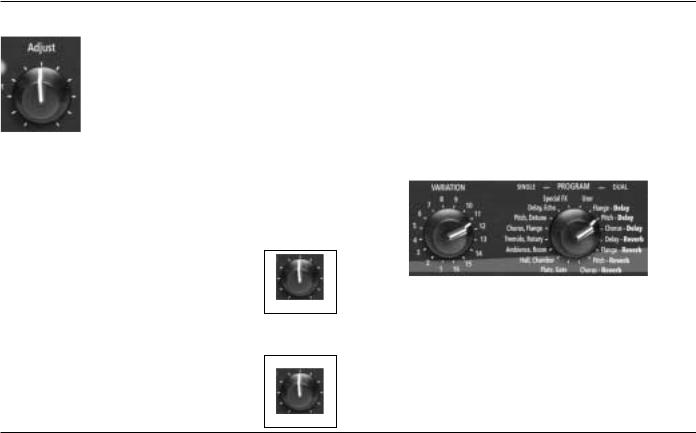
Basic Operation
Lexicon
ADJUST
The Adjust knob has been customized for each individual program, and in most cases controls several parameters at once to handle complicated editing processes. For instance, Adjust controls the “liveness” of space in many Chamber and
Room programs by changing decay, EQ, and early reflections simultaneously.
The behavior of the Adjust knob is also customized for different functions:
•It can act as a linear control, at its minimum value when set to the 7 o’clock position and its maximum value when set to the 5 o’clock position.
•It can act as a bipolar control, at its minimum value when set to the 12 o’clock position, like a cut/boost EQ control.
DARK LIGHT
MIN
– |
+ |
MAX MAX
SELECTING PROGRAMS
All programs can be selected with the front panel PROGRAM and VARIATION knobs. The PROGRAM knob selects either a SINGLE, DUAL, or User program. SINGLE program selections are arranged around the left side of the knob; DUAL and User program selections are arranged around the right side of the knob. The VARIATION knob selects among 16 program variations, arranged around the knob.
SINGLE PROGRAMS
When the PROGRAM knob is set to a SINGLE program:
•VARIATION knob settings 1 to 8 will load eight variations of the first effect.
•VARIATION knob settings 9 to 16 will load eight variations of the second effect.
2-2
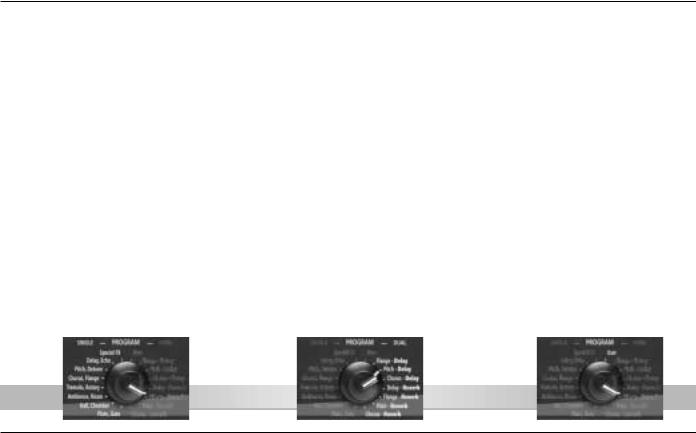
MPX 110
Basic Operation
•See pages 4-2 to 4-17 for more information about SINGLE programs.
For example, when Plate, Gate is selected:
•VARIATION knob settings 1 to 8 will load eight different Plate program variations.
•VARIATION knob settings 9 to 16 will load eight different Gate program variations.
When Special FX is selected:
•VARIATION knob settings 1 to 16 will each load one program.
•See page 4-18 for more information.
SINGLE |
DUAL |
Programs |
Programs |
DUAL PROGRAMS
When the PROGRAM knob is set to a DUAL program:
•VARIATION knob settings 1 to 16 load 16 different program variations. Each program contains both effects.
•See pages 4-20 to 4-35 for more information about DUAL programs.
USER PROGRAMS
When the PROGRAM knob is set to User:
•VARIATION knob settings 1 to 16 will each load one memory location available for storing User programs. When shipped, these locations will contain duplicates of presets.
•See page 4-38 for more information about User programs.
User
Programs
2-3
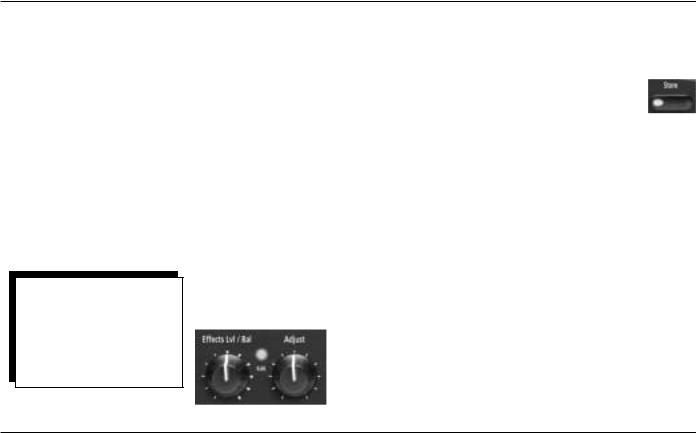
Basic Operation
Lexicon
EDITING PROGRAMS
The front panel Adjust and Effects Lvl/Bal knobs can both be used to edit programs. The Adjust knob provides instant manipulation of critical program parameters. These parameters are arranged under the knob, meaning that just one turn is all that is required to customize a program to personal taste. The Effects Lvl/Bal knob can be used to control effect level in SINGLE programs, or effect balance in DUAL programs.
The unit recognizes changes made with either knob as edits. When edits are made, the front panel Edit LED will light to indicate that the selected program has been modified but not stored.
Use the Adjust knob to edit the selected program, and the Effects Lvl/Bal knob to control effect level in SINGLE programs or effect balance in DUAL Programs. The Edit LED will light to indicate that the selected program has been modified from its stored condition.
STORING PROGRAMS
To store a program in a User memory location:
1.Press the Store button. The Store LED will flash slowly to indicate that the store function is activated.
2.To continue saving the program, set the PROGRAM knob to User. To cancel the store function without saving the program, make sure the PROGRAM knob is not set to User, then press the Store button again.
3.Set the VARIATION knob to select one of the 16 User memory locations.
4.Press the Store button to save the program to the selected location. The Store LED will flash quickly until the store process is complete. The Edit LED will no longer be lit when the saved version becomes the selected program.
2-4
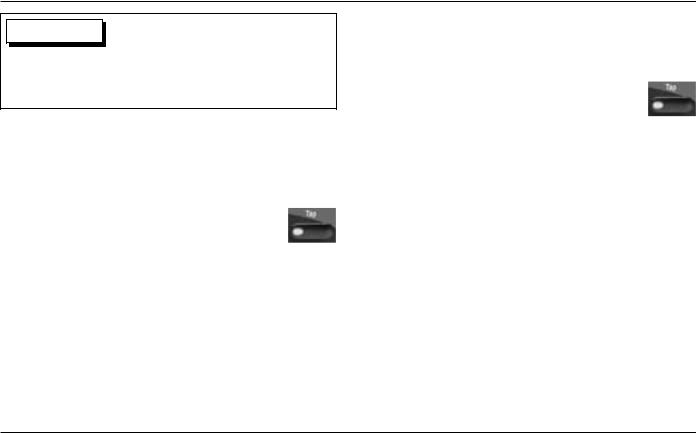
MPX 110
Basic Operation
CAUTION
When new programs are stored in a User memory location, programs that were previously stored at that location will be automatically replaced.
TAP TEMPO
VARYING RHYTHM
Tap Tempo can be used to match the delay times and modulation rates of tempo-based programs with those of the music. The Tap LED
will flash whenever a tempo-based preset is loaded. To set tempo from the front panel, press the Tap button twice in time with the music. It is not required to enter what could be the delay time in milliseconds. Just press the Tap button twice, and the unit will calculate the appropriate delay time. To change tempo, press the Tap button twice again in the new rhythm. Changes made to tempo with the Tap button are not considered program edits, and will not cause the Edit LED to light.
AUDIO TAP
To use audio input to set tempo:
1.Press and hold the Tap button for 2 seconds. (The optional dual footswitch allows the musician to remain in contact
with the instrument while pressing and holding the Tap button.)
2.While holding the Tap button, play two short notes in rhythm, then release the Tap button. The unit will automatically calculate tempo based on the time lapse between the two notes.
Audio tap is a must for live performances. It offers a simple method of setting delay times and modulation rates to match the music.
. . . continued on page 2-6
2-5

Basic Operation
Lexicon
Tap Tempo (continued from page 2-5)
GLOBAL TEMPO
Most factory presets are stored with individual tempo rates, which can be customized to suit personal taste. Tap in the new tempo, then store the modified version of the preset in a User memory location (see page 2-4).
To recall the tempo rate stored with each program, set the System Mode parameter Tempo to Program. The unit will apply the individual tempo setting of each program as it is loaded. To apply the current tempo rate to all programs, set the System Mode parameter Tempo to Global. The unit will ignore individual tempo settings and apply the current tempo setting to each program as it is loaded. (The Tap LED will flash when a tempocontrolled program is loaded.)
BYPASS
The Bypass button can be used to mute audio or to force the unit to pass only dry, unprocessed audio. Its function depends on the
setting of the System Mode parameter Bypass. When set to Bypass Dry, the unit sends only dry, unprocessed audio to the outputs. When set to Mute Input, the unit mutes the inputs only. Running effects will continue their natural decay. Bypass functions can also be activated with a footswitch or MIDI control device (see pages 1-8 and 5-5).
When pressed and held for 2 seconds, the Bypass button also activates System Mode. (See Section 3 for more information about System Mode.)
2-6

|
3 |
|
System Mode |
Overview ......................................................................................... |
3-2 |
System Mode Parameters & Functions............................................. |
3-3 |
